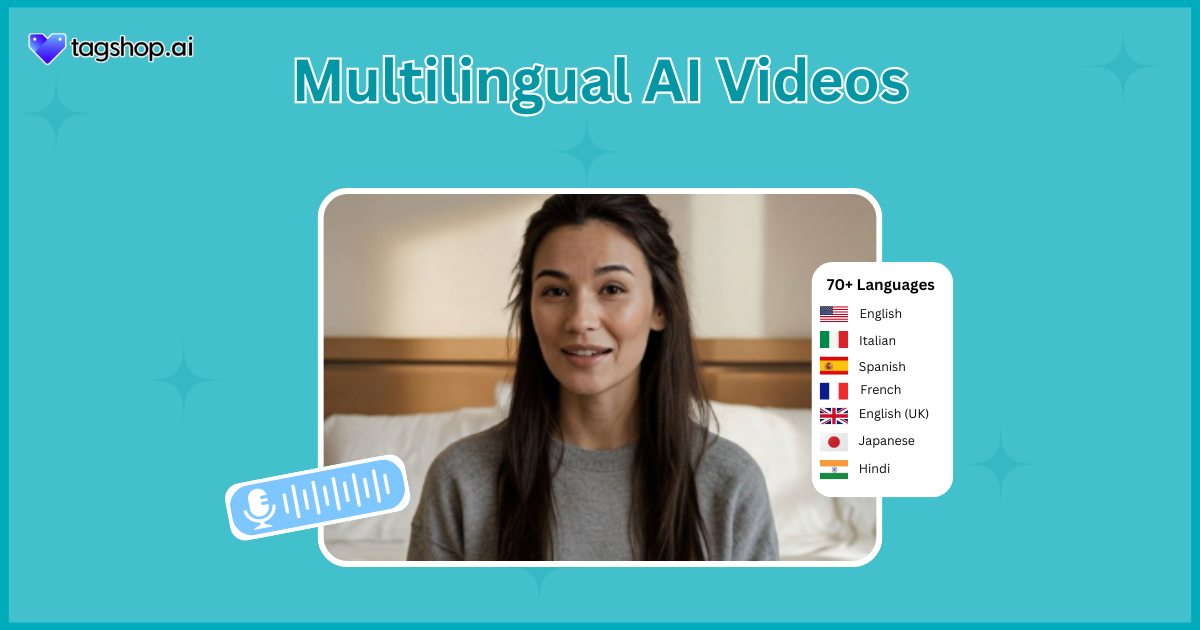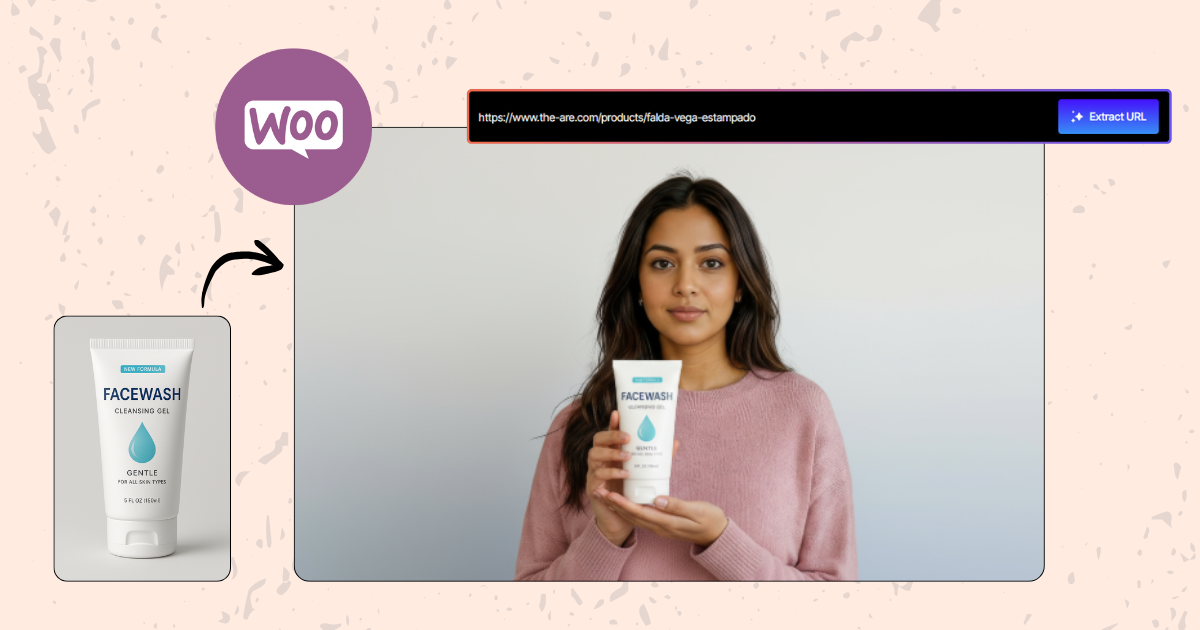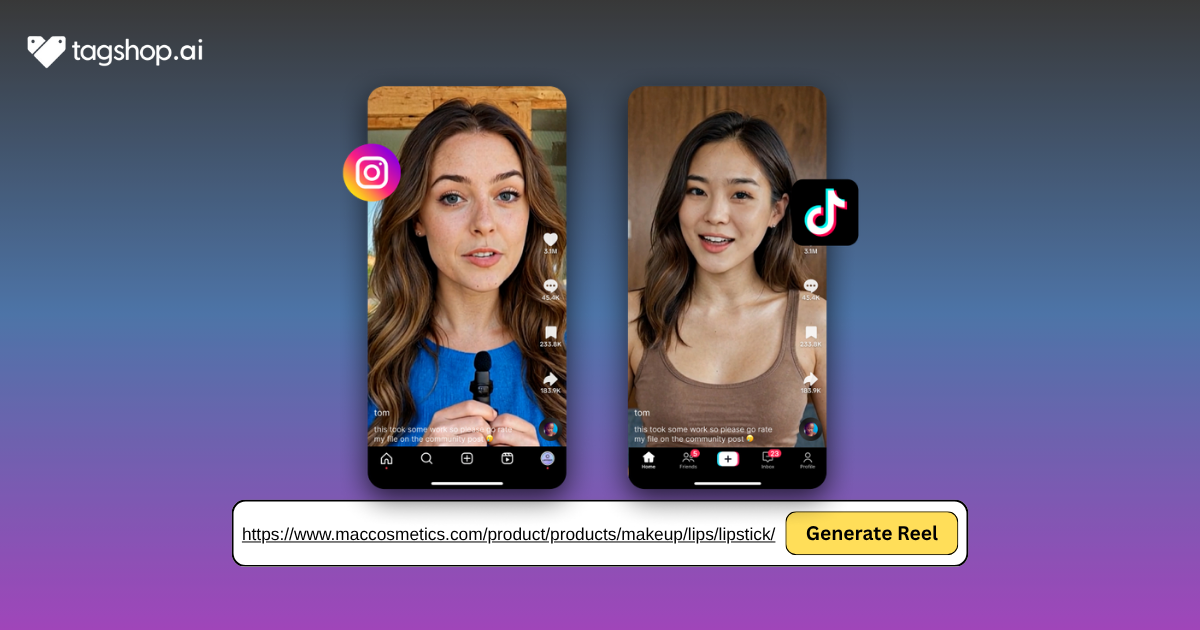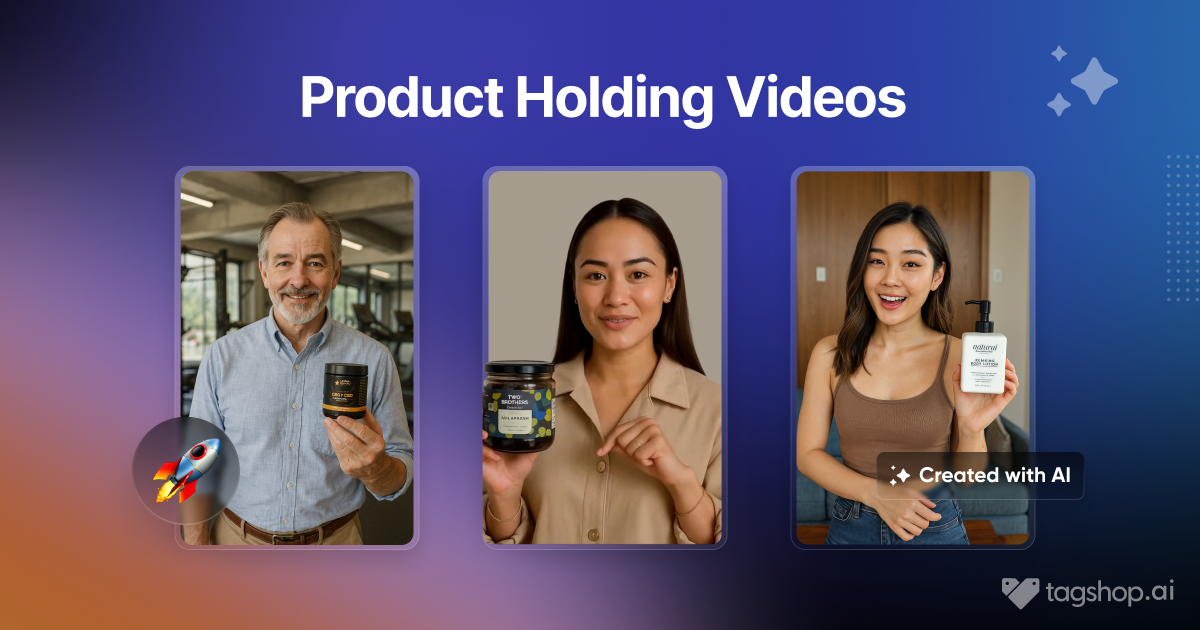How to Create Multilingual AI Videos to Reach Global Audiences
Imagine you are a business owner from America, and now you want to capture growing markets like China or India, what would be your first step? Developing brand awareness, right? With culturally strong countries, you need to create brand awareness using their language, which is how they will relate to it more.
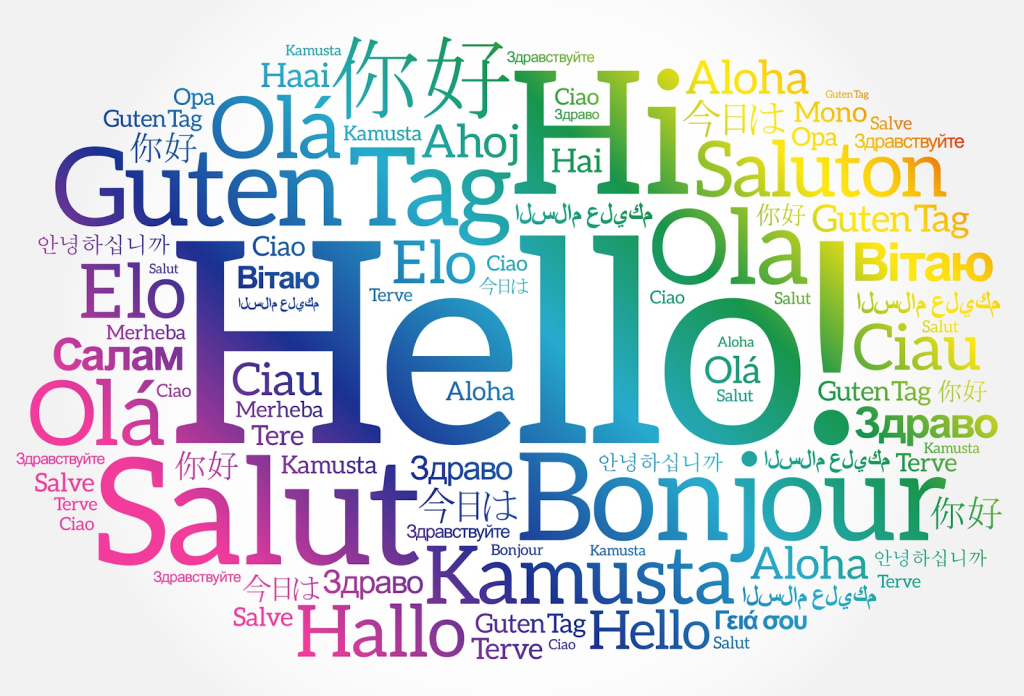
Multilingual videos are the most effective tool for such measures. Various AI video platforms enable you to create multilingual AI videos. If you want to learn about those tools and everything related to making multilingual videos, then this blog is exclusively for you.
What Are Multilingual AI UGC Videos?
Let’s start with basics, multilingual AI UGC videos are AI-generated clips mimicking user content like casual reviews or demos using avatars that speak multiple languages naturally. Unlike static translations, they adapt for cultural fit, feeling like a local TikTok influencer’s post. Tools like Tagshop AI exemplify this: Avatars and URL-fed scripts deliver UGC-style ads in 20+ languages, blending realism with efficiency.

Core elements include AI voiceovers, AI voice cloning with accents and emotions, lip-syncing for natural delivery, subtitles for accessibility, and scripts translated or adapted via AI. Tagshop integrates auto-scripts from product URLs, diverse voices, and captions, ensuring 95% realism without actors. This tech cuts dubbing costs while maintaining UGC’s raw appeal.
Why Multilingual Content Matters in 2025

In 2025, English holds a good percentage of web content, but non-English speakers dominate. Over 50% of users prefer their native language and are 73% more likely to make a purchase if the information is localized. Mandarin (1.1 billion speakers) and Hindi (602 million) lead, yet only 5-10% of sites cater to them fully.
As per Weglot’s data, 60% skip English-only sites, and 65% prefer poor-quality native content over perfect English. 82% of traffic on videos consists of clips from non-English markets, such as Arabic (with a 5.2% growth rate). Additionally, 76% of users always seek native sites. Bottom line: Ignoring this misses 40% of potential customers.
Localization isn’t translation, it’s adapting for culture, like swapping US humor for Japanese subtlety. In video marketing, where 91% aid purchases, localized clips build affinity: 92% trust UGC more, and multilingual clips boost SEO in regional searches. With 84 minutes daily video consumption, non-localized content flops, e.g., direct translations ignore accents or gestures, dropping engagement.
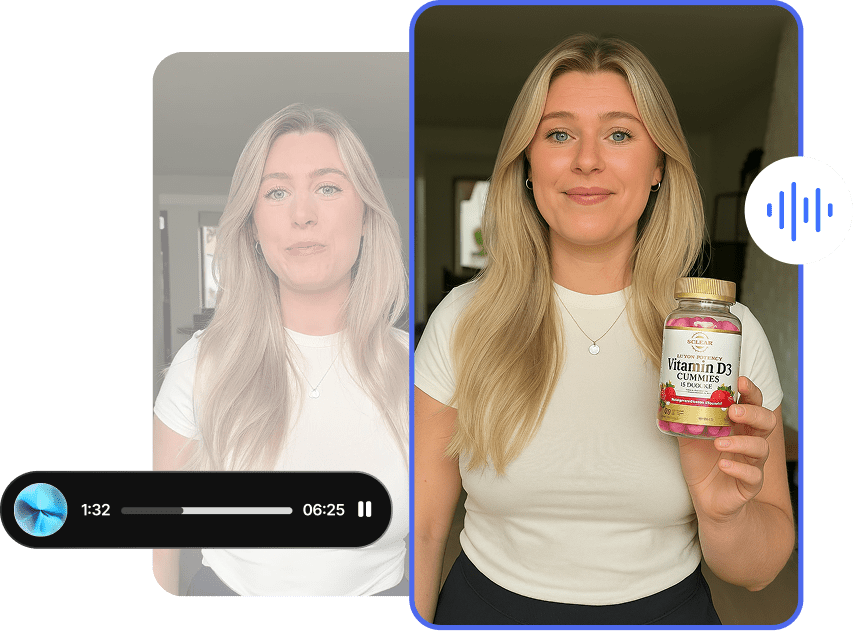
How to Create Multilingual AI UGC Videos (Step-by-Step)
You don’t need rocket science to create multilingual AI UGC videos; it can be done within minutes. Here are the steps you need to follow:
Step 1. Choose an AI UGC Tool with Language Support (E.g., Tagshop AI)
Start with a tool like Tagshop AI, supporting 20+ languages and 100+ avatars for UGC-style creation. Tagshop specializes in eCommerce UGC batch videos in minutes for $23/month. Sign up, verify language needs (e.g., Mandarin for China). You can also use free trial tests for multilingual output without commitment.
Step 2. Input Product Details or URLs
Paste Shopify/Amazon URLs, and AI pulls images, features, and descriptions automatically. For custom, add scripts or value props.
Step 3. Generate Script in Primary Language
Create a base script in English (or native), focusing on hooks and CTAs. Tagshop’s AI generates 3-5 options, UGC-style: “This gadget changed my routine!” Keep it concise (15-30s); test tones (testimonial vs. explainer). Emphasize making clear, translation-friendly scripts with pauses.
Step 4. Translate Script Using Built-in or Custom Translator
Use built-in AI for 20+ languages, adapting idioms (e.g., US “home run” to German equivalent). Tagshop auto-translates with cultural tweaks and takes a review for nuance.
Step 5. Select Avatar, Voice, and Language Accent
Choose from 100+ diverse avatars matching regions (e.g., Asian for Mandarin). Tagshop offers accents/tones for authenticity, and lip-sync ensures natural flow.
Step 6. Add Brand Elements and Subtitles
Overlay logos, CTAs (“Shop Now” localized), and auto-subtitles for 80% muted views. Tagshop keeps UGC raw but branded; add cultural visuals (e.g., festive backgrounds for India). Subtitles in native script boost retention.
Step 7. Export in Platform-Specific Formats (TikTok, YouTube, etc.)
Generate and download in vertical (Reels/Shorts) or horizontal formats, optimized for platforms. Utilize batch exports, which enable 100+ variants for A/B testing across regions.

Benefits of Creating Multilingual AI UGC Videos

Multilingual AI UGC videos are like a superpower for reaching new markets, and they come with some serious perks. Whether you’re eyeing customers in Tokyo or Buenos Aires, multilingual AI UGC videos can be your key to success. Let’s dive into why multilingual AI videos are your ticket to global stardom.
1. Global Reach Without Hiring Local Creators
Imagine trying to find and hire creators in every corner of the world. Sounds exhausting, right? With AI UGC videos, you skip the hassle of tracking down local talent or paying hefty fees for each shoot. Tools like Tagshop AI let you create authentic, user-generated-style content in over 20 languages, from Mandarin to Spanish, without ever needing to ship products or coordinate with influencers.
It’s like having a global team of creators at your fingertips, ready to connect with audiences in places like China or LATAM. This means you can tap into new markets without the logistical nightmare of managing creators across time zones.
2. Faster Go-to-Market in New Regions
Launching in a new market usually feels like a marathon, weeks of planning, translations, and production. But with AI UGC videos, you’re sprinting to the finish line in hours. It’s perfect for jumping on trends or launching in new regions without missing a beat.
No waiting for creators or studios, just quick, quality content that gets your brand in front of new eyes, pronto. It’s like having a fast-pass for international launches.
3. Consistent Messaging Across All Languages
Keeping your brand’s vibe consistent across languages is tough; translations can dilute your message or sound off-brand. AI UGC videos solve this by adapting scripts smartly, ensuring your core message stays intact whether it’s in French, Hindi, or Arabic. This consistency builds trust and strengthens your global presence.
4. Cost-Effective Localization at Scale
Hiring translators, voice actors, and editors for every language? That’s a budget buster. AI UGC videos slash costs by handling localization in-house, Tagshop’s $23/month plan lets you create batches of videos in multiple languages without extra per-video fees. It’s like getting a whole production crew for the price of a coffee subscription, scaling effortlessly to markets big or small.
You can churn out dozens of videos for different regions without worrying about ballooning costs. Want a campaign in 10 languages for your eCommerce store? Tagshop’s AI delivers, from script to final cut, without the need for expensive dubbing studios or local shoots. This affordability means you can test new markets or ramp up campaigns without sweating the price tag.
5. Better Ad Relevance and Conversion Rates
In today’s market, people want content that feels like it’s made for them. Multilingual AI UGC videos nail this by matching avatars, voices, and scripts to local cultures, making ads feel personal and relatable. Various tools in the market let you create videos with avatars that look and sound like your target audience, whether it’s a young shopper in Seoul or a professional in Dubai.
Best Practices for Multilingual UGC Video Creation
Crafting multilingual AI UGC videos that resonate worldwide is an art, and it’s all about making your content feel like it was made by a local, not just translated by a bot. These best practices are inspired to ensure your campaigns connect, engage, and convert, no matter the language or culture.
1. Localize, Don’t Just Translate: Adapt Slang, Tone, and Cultural References
Translation is just the start; localization is where the magic happens. A direct word-for-word swap, like turning “This is a home run!” into a literal Japanese phrase, can feel awkward or confusing to your audience. Instead, adapt slang, tone, and cultural references to fit the vibe, like swapping casual US banter for a more formal tone in Japan or playful emojis for Brazil.
Tagshop AI’s clever script tweaks make this easier, automatically adjusting phrases to sound natural while keeping your brand’s heart intact. Get a native speaker to review your scripts; it’s like having a local friend double-check your work to ensure it lands right.
2. Match Avatar Appearance and Voice to Regional Expectations
Your AI avatar is your video’s star, so make sure it looks and sounds like someone your audience would trust. A generic avatar won’t cut it. Imagine using a single Western-looking character for an Indian campaign; it just feels off.
You have various tools like Tagshop AI, Heygen, and more that offer over 100 diverse avatars, letting you pick ones that reflect your audience’s ethnicity, age, or style, like a vibrant young creator for India or a polished professional for Germany. Pair that with region-specific accents or tones to make it click.
3. Use Subtitles Even for Spoken Language
Ever watch a video on mute while scrolling? Most people watch 80% of social videos without sound, so subtitles are non-negotiable. Even if your video’s spoken in the local language, captions make it accessible to everyone, from those with hearing challenges to folks sneaking a peek in a quiet café. AI video generator tools auto-generate subtitles in native scripts, like Arabic or Hindi, keeping them short and punchy to match the UGC vibe.
4. Test Different Scripts per Region (What Works in the US May Not Work in Germany)
Humor or hooks that kill it in one country can flop in another. Think a sarcastic USA, Chandler Bing-type quips falling flat in Germany’s straightforward culture. That’s why A/B testing is your best friend. Use AI UGC generator videos to whip up multiple script versions, tweaking tone, humor, or style for each region, like a playful, trendy vibe for Brazil or a no-nonsense explainer for Germany. Test them on a small ad budget to see what sparks joy with your audience.
5. Include Platform-Specific CTAs and Offers per Region
Your call-to-action (CTA) is the nudge that turns viewers into buyers, but a generic “Shop Now” won’t cut it everywhere. Tailor CTAs to local platforms like linking to WeChat for China or Mercado Libre for LATAM (Latin American countries) to make shopping seamless.
Mistakes to Avoid When Creating Multilingual AI UGC Videos
Crafting multilingual AI UGC videos is a fantastic way to connect with audiences worldwide, but it’s easy to trip up if you’re not careful. Let’s make sure your videos land right, no matter the market!

1. Direct Machine Translation Without Review
Relying solely on AI for video translations is like trusting a robot to tell a joke; it might get the words right but miss the punchline. Direct machine translations often lose nuance, turning a catchy US phrase like “This is a game-changer!” into something clunky or confusing in another language, like Spanish or Mandarin.
Getting a native speaker to review your script is like having a friend check your outfit before a big event. This extra step ensures your video feels natural and engaging, avoiding awkward translations that could make viewers scroll past instead of clicking through.
2. Ignoring Cultural Context or Local Customs
Nothing tanks a campaign faster than a cultural faux pas like using a gesture that’s friendly in the US but rude in the Middle East. Ignoring local customs or context can make your UGC video feel tone-deaf, alienating your audience.
For instance, a festive ad in India might include Diwali lanterns, while a German version sticks to clean, minimalist visuals. Taking time to research local holidays, slang, or taboos ensures your video feels like it was made by someone who gets the culture, building trust and connection.
3. Using the Same Avatar or Voice for All Languages
Imagine a single avatar with a British accent selling products from Mexico to Japan; it just doesn’t vibe. Using the same avatar or voice across all languages screams “outsider” and breaks the UGC authenticity.
Mixing it up is key to making videos feel local. Testing different avatars ensures your video feels like it’s coming from a neighbor, not a generic bot, making viewers more likely to engage and trust your brand.
4. Skipping Captions for Accessibility
Skipping captions is like locking out half your audience, as mentioned before, 80% of social videos are watched on mute, so you’re missing a huge opportunity if you don’t include them. Captions make your videos accessible to everyone, from those with hearing challenges to folks watching in a noisy subway. Think of captions as the cherry on top; they ensure your message lands, no matter the setting.
Top Industries That Benefit from Multilingual AI UGC Videos
Multilingual AI UGC videos are like a secret weapon for reaching global audiences, and certain industries are reaping massive rewards from them. Let’s dive into the top sectors cashing in on this trend, with a conversational, human-touch spin to keep it real and inspiring.
1. eCommerce – Product Videos for Regional Sites
Picture this: You’re an eCommerce brand launching in Latin America, but your product videos are stuck in English, crickets, right? Multilingual AI UGC videos fix that by creating demos in local languages, like Spanish for LATAM shoppers, that feel like a friend showing off their latest buy.

Tagshop AI makes it a breeze, turning Shopify product URLs into videos ( Localized) that showcase your products in a way that clicks with regional audiences, from Mexico to Argentina.
These videos are all about building trust and excitement.
Imagine a casual unboxing clip in Portuguese for Brazil, highlighting your skincare line’s benefits with a relatable avatar. This approach makes shoppers feel seen, encouraging them to hit “Add to Cart” without hesitation. Tagshop’s ability to churn out region-specific demos means you can launch in new markets without the hassle of hiring local creators, keeping your brand front and center.
2. SaaS – Onboarding, Tutorials, and Feature Explainers
SaaS companies, you know the drill: New users need hand-holding to get the most out of your platform, but language barriers can make onboarding a nightmare. Multilingual AI UGC videos come to the rescue with tutorials and explainers in languages like Mandarin or German, delivered by avatars that feel like a friendly tech coach. Hyper-realistic avatars guide users through features or setup steps, making complex software feel approachable. These videos save time and keep users happy.
3. DTC Brands – Influencer-Style Video Ads in Different Languages
Direct-to-consumer brands thrive on buzz, and nothing says “buy me” like an influencer-style ad that feels like a real customer’s rave review. Multilingual AI UGC videos let DTC brands create these ads in languages like Hindi or French, tailored to local markets. Imagine a fitness brand dropping a Hindi ad where a lively avatar shares how your protein powder fits their daily hustle.
It’s relatable and clickable. These localized ads let you tap into cultural trends, like festival season in India or summer vibes in Spain, without needing to hire influencers in every market. Tagshop’s diverse avatars and scripts keep your brand’s story authentic, driving clicks and building a loyal fanbase.
4. Education & Training – Courses and Onboarding in Native Tongues
Whether you’re running an edtech platform or corporate training program, getting learners engaged is tough if your content isn’t in their language. Multilingual AI UGC videos make courses and onboarding feel personal, with avatars delivering lessons in native tongues like Arabic or Japanese. These videos break down barriers, making education accessible and inviting, so learners stay motivated and complete their courses with ease.

Conclusion
Multilingual AI videos open gates for your brand to get customers across geographical boundaries. Keep in mind that translating a video and converting it are two different aspects. Translation merely takes word-for-word translation, while converting a video into multiple languages enables you to use cultural, traditional, and local references to make it more relatable. Various tools in the market allow you to make such videos and increase your brand awareness. So what are you waiting for? Start generating multilingual AI videos, and make your brand a global hit.

